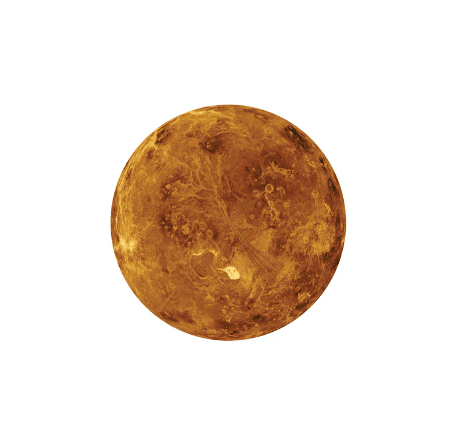Venus is a rocky planet, often compared to Earth due to its similar size and mass.
However, the similarities end there. Venus is the hottest planet in the Solar System due to a powerful greenhouse effect caused by its atmosphere, which is 90 times thicker than Earth’s.
It rotates very slowly and in the opposite direction to all other planets. Its rotation is so slow that a day on Venus is longer than a year.
According to the Romans, Venus was the most beautiful of the planets, shining brightly like the goddess it was named after. (CNES)

| Caractéristiques | Venus | Terre |
| Diamètre | 12 100 km | 12 750 km |
| Rapport de masse | 0,82 | 1 |
| Rapport de gravité | 0,9 | 1 |
| Distance de soleil (UA) | 0,72 | 1 |
| Inclinaison / Axe de rotation | 2,6° | 23,5° |
| Période de rotation | 243 j | 1 j |
| Révolution autour du soleil | 225 j | 365 j |
| Température max | +490°C | +58°C |
| Température min | +446°C | -89°C |
| Lunes | 0 | 1 |
Venus is the second closest planet to the Sun.
Like the other planets in the solar system, Venus formed through complex processes about 4.5 billion years ago. Here is an overview of its formation:
Formation Process of Venus
- Protoplanetary Disk Formation: Venus emerged from a disk of gas and dust surrounding the young Sun, known as the protoplanetary disk. This disk resulted from the gravitational collapse of the solar nebula.
- Accretion of Matter: Tiny dust particles within this disk were drawn together by gravity, gradually forming larger objects called planetesimals. These then merged into planetary embryos, which eventually became planets.
- Differentiation: As Venus grew, denser materials sank to its core, forming a metallic core, while lighter materials formed the mantle and crust.
- Atmosphere Formation: Venus accumulated an atmosphere rich in carbon dioxide, with traces of water vapor, nitrogen, and other gases. These gases originated from the protoplanetary disk and geological processes on the young planet.
- Cooling and Stabilization: Once Venus reached its final size, it began cooling, while volcanic and tectonic activity shaped its surface. Over time, its atmosphere stabilized.
Key Characteristics of Venus
- Often called Earth’s “sister” planet due to their similar size and rocky composition.
- Orbits the Sun every 224.7 Earth days but has an extremely slow rotation of 243 Earth days.
- Rotates in the opposite direction compared to most planets.
- Has an extremely dense atmosphere, creating a runaway greenhouse effect that keeps surface temperatures at about 462°C.
For more information, visit:
